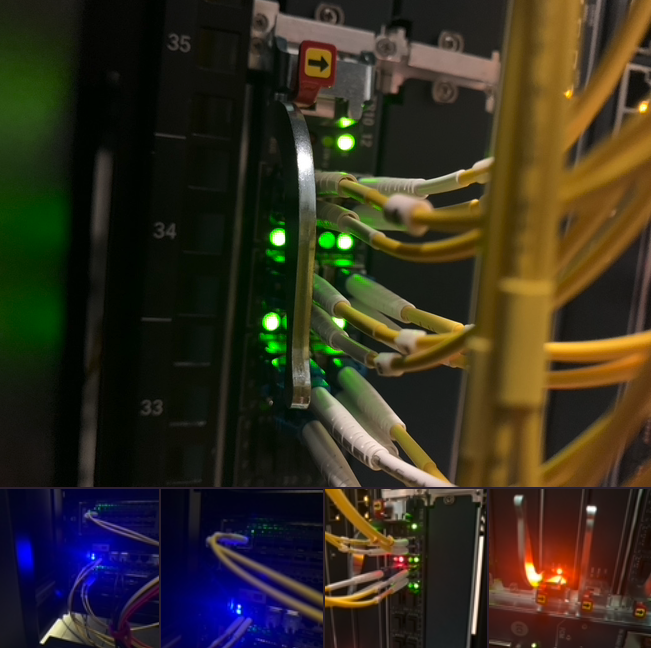Dit bericht verscheen eerder bij Afiber
Many organizations across various sectors are increasingly relying on high-speed, low-latency connections to drive their critical business operations. The spectrum of optical networks, dark fiber, and wavelength-division multiplexing (WDM) lies at the heart of these connections.
In this series, our network team will dive into technical aspects of dark fiber and WDM to explain various topics to take into account when designin, building and maintaining optical networks, with tips and trics for optimizing equipment.
We will focus on key elements that influence the performance and functionality of optical networks:
Episode 1: Chromatic Dispersion
An in-depth look at this common phenomenon in WDM links, its implications, and strategies to mitigate its effects.
Episode 2: Reflection
A comprehensive exploration of optical reflections, their causes, and methods to minimize their impact on signal integrity.
Episode 3: Noise & Signal
A detailed examination of noise in optical communication and the essential techniques to maintain signal quality.
Episode 4: Optical Overload
A critical review of the challenges posed by optical overload, and the necessary safeguards to prevent it.
Read the first episode below and stay tuned for the next episodes as we delve deeper into optical networks.
Subscribe and follow our company page to get notifications when we share new updates.
Episode 1 – Chromatic dispersion |
Chromatic dispersion is a phenomenon that occurs in wavelength-division multiplexing (WDM) links, which transmit multiple optical signals simultaneously over different wavelengths. It refers to the spreading or broadening of optical pulses as they propagate through an optical fiber due to the different wavelengths traveling at different speeds.
In WDM systems, each wavelength channel carries its own data stream, and these channels are combined and transmitted together through a single optical fiber. However, because different wavelengths have slightly different propagation characteristics, they can experience different propagation delays. This leads to a phenomenon known as group velocity dispersion (GVD), which is a major cause of chromatic dispersion.
Chromatic dispersion can be divided into two types:
1. Material Dispersion
This type of chromatic dispersion arises from the fact that different wavelengths of light travel at different speeds in the fiber material itself. It occurs due to the variation in refractive index with respect to wavelength. In most optical fibers, material dispersion is characterized by the fact that longer wavelengths travel faster than shorter wavelengths. As a result, different wavelengths spread out and overlap with neighboring symbols, causing intersymbol interference and degradation of signal quality.
2. Waveguide Dispersion
Waveguide dispersion occurs due to the waveguide structure of the fiber. It is caused by the variation in effective refractive index for different wavelengths, leading to differences in propagation speeds. Waveguide dispersion is strongly influenced by the fiber’s geometric parameters, such as core size, numerical aperture, and refractive index profile. This dispersion can be either positive or negative, depending on the design of the fiber.
The effects of chromatic dispersion can lead to signal distortion and limit the transmission distance and data rate of WDM systems. As the optical pulses spread out over longer distances, they can overlap with adjacent pulses, making it challenging to distinguish the individual wavelengths and decode the transmitted information accurately.
Below a short explainer video from our supplier and partner EXFO:
To mitigate the impact of chromatic dispersion in WDM links, several techniques are employed, including:
Dispersion Compensation Modules (DCMs)
These modules are used to actively compensate for the dispersion effects by introducing an opposite and equal amount of dispersion. DCMs are usually placed at strategic points in the fiber link to counteract the accumulated dispersion and restore the quality of the transmitted signals.
Imagine you’re working on a network that spans several hundred kilometers, using WDM technology to transmit data. After some distance, you notice signal degradation due to chromatic dispersion. Here, a DCM can be a game-changer. You can install DCMs at strategic intervals, say, every 80 kilometers, based on the specific dispersion characteristics of your fiber. By generating an equal but opposite dispersion, the DCMs effectively cancel out the accrued dispersion, preserving the integrity of your transmitted signals.
Dispersion-Compensating Fiber (DCF)
DCF is a type of optical fiber designed to have a dispersion opposite in sign to the transmission fiber. By incorporating a section of DCF into the link, the dispersion can be effectively compensated, reducing the overall chromatic dispersion.
Suppose you’re dealing with a high-capacity network spanning across metro cities. You observe that standard single-mode fibers (SMFs) used are introducing significant chromatic dispersion, impacting data rates. To mitigate this, you can splice in segments of DCF at regular intervals along your SMF link. These DCF sections, having opposite dispersion characteristics, will counteract the dispersion from the SMFs, thus ensuring high-speed, high-quality data transmission.
Forward Error Correction (FEC)
FEC techniques can be employed to improve the system’s resilience to chromatic dispersion. These techniques introduce redundancy into the transmitted data, allowing the receiver to detect and correct errors caused by dispersion-induced signal distortions.
Consider you’re managing a WDM system, where service interruptions for maintenance are costly and impractical. Here, FEC becomes crucial. By adding redundant data into the transmission, FEC allows the receiver end to detect and correct any errors introduced due to chromatic dispersion. Implementing FEC at the transmitter end can significantly improve system performance and reliability, especially in these challenging undersea environments.
Optical Signal Regeneration
On longer distance WDM links, optical signal regeneration devices can be used to restore the degraded signals by converting them into electrical signals, reshaping them, and retransmitting them with improved quality.
Let’s say you’re in charge of a long-haul terrestrial fiber network spanning thousands of kilometers. Over such vast distances, chromatic dispersion and signal attenuation can degrade signal quality significantly. By deploying optical signal regenerators at specific distances, you can overcome this challenge. These devices convert the degraded optical signals back into electrical signals, clean up the noise, and retransmit them as fresh optical signals, thus ensuring the quality of data over the entire network length.
It is important to manage and compensate for chromatic dispersion in WDM links to maintain high-quality transmission and maximize the achievable data rates over long distances. By employing appropriate dispersion compensation techniques and optimizing system parameters, the impact of chromatic dispersion can be minimized, enabling reliable and efficient WDM communications.
Stay tuned for the next episode on reflection as we delve deeper into optical networks.
More information or questions on chromatic dispersion or would you like to discuss optical projects? Contact our team or call +31(0)20 225 0025.
About AFIBER
AFIBER is an independent provider of fiber optic connectivity for business customers and service providers. We help organizations with the delivery and management of high-quality networks between branches, data centers, cloud providers, and providers of network and IT services.
AFIBER offers business customers fiber optic coverage in a large part of the Netherlands. This fiber optic network is connected to the main data centers and various regional and national fiber optic networks. This enables us to make an independent choice for our customers for the right connectivity for your company network.
Dit bericht verscheen eerder bij Afiber













